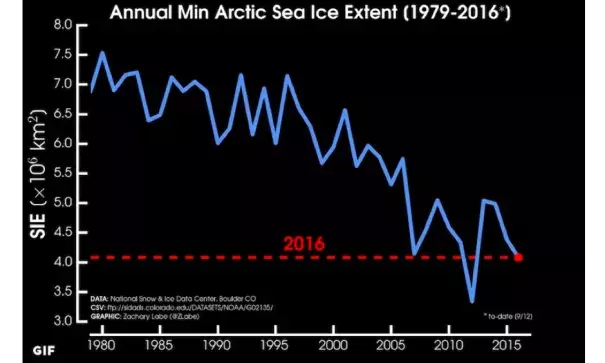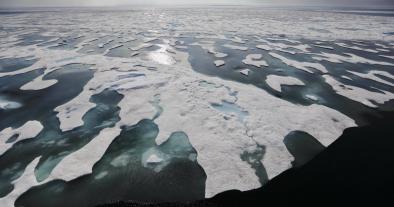Headline
Degraded and Disheveled, Arctic Sea Ice Ties for Second-Lowest Extent on Record
Arctic

Each year’s minimum in Arctic sea ice extent from 1979, when satellite measurement began, through 2016 (assuming that the September 10 minimum holds). Units are millions of square kilometers. Image: Zack Labe, @Zlabe.
The National Snow and Ice Data Center (NSIDC) announced on [September 15] that the extent of sea ice in the Arctic Ocean has apparently hit its summer minimum. The value of 4.14 million square kilometers (1.60 million square miles) reached on September 10 comes in just behind the record-low extent of 2012 and in a statistical tie with 2007 for second place (see Figure 1). Although refreezing has begun, it’s possible that a late burst of melting could lead to an even lower value in the next few days. This year’s minimum came in below the 4.38 million sq km predicted in August by the median of 39 outlooks submitted by participants in the Sea Ice Prediction Network
Related Content
Science Source
| World Weather Attribution
Unusually high temperatures at the North Pole, winter 2016
Science Source
| Geophysical Research Letters
Accelerated increase in the Arctic tropospheric warming events surpassing stratospheric warming events during winter
S.‐Y. Simon Wang, Yen‐Heng Lin, Ming‐Ying Lee et al
Science Source
| Bulletin of the American Meteorological Society
EEE 2016: CMIP5 Model-based Assessment of Anthropogenic Influence on Highly Anomalous Arctic Warmth During November–December 2016
Jonghun Kam, Thomas R. Knutson, Fanrong Zeng et al
Headline

Dec 12, 2017 | Mother Jones
The Arctic is warming faster than at any point in the past 1,500 years


